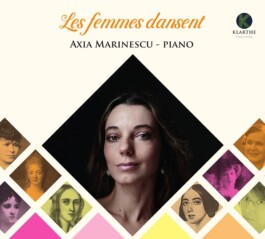


November 13th 2021
[Interview] Élisabeth Jacquet de la Guerre, Louise Farrenc, Pauline Viardot, Marie Jaëll, Cécile Chaminade, Mel Bonis, Germaine Tailleferre and Sophie Lacaze: all these women, French composers, are at the heart of pianist Axia Marinescu's new album "Les Femmes Dansent". It has just been released by Klarthe and is placed under the sign of movement and the female soul. The Centre Européen de Musique went to meet its interpreter.

How did the idea for the album come about?
It came from a double passion, music and dance. At the age of seven, in Bucharest, I started playing the piano. My teacher at the time wanted me to devote myself entirely to it. Dance, and everything related to it, has remained a passion that has never left me since that time. In designing the programme for this album, I wanted to link piano and dance. Dance is omnipresent in the music. At the same time, I discovered forgotten women artists. They are the starting point for this album. It was with these female musical figures that I began researching to find scores that were little or never played. Among these female composers: Pauline Viardot, whose story I discovered through literature, that of Ivan Tourgueniev. She was both a visionary and a humanist.
In your career, several disciplines are intertwined: dance, music, philosophy... How do you link these different passions in your quest for beauty and elegance?
It's a question of need. Art and beauty come together in many ways. Gauguin said that beauty is eternal and takes many forms. There is, for example, the beauty of sound for music and the beauty of thought for philosophy. The musician needs to be nourished by everything and cannot ignore other disciplines.
You were born in Romania, speak five languages, have travelled to many countries for music and now live in France. Do you consider, through your background, that music can be considered as the European identity par excellence?
Through the education my family gave me, I grew up with these values. Values that have remained with me since I left Romania at the age of 16. This identity, born of diversity, is for me the most important contribution. It is with this that I was able to build my own identity. It is always very important to go and see, to discover elsewhere. There is a real artistic thread and this magnificent diversity throughout Europe.
November 13th 2021
[Interview] Élisabeth Jacquet de la Guerre, Louise Farrenc, Pauline Viardot, Marie Jaëll, Cécile Chaminade, Mel Bonis, Germaine Tailleferre and Sophie Lacaze: all these women, French composers, are at the heart of pianist Axia Marinescu's new album "Les Femmes Dansent". It has just been released by Klarthe and is placed under the sign of movement and the female soul. The Centre Européen de Musique went to meet its interpreter.

How did the idea for the album come about?
It came from a double passion, music and dance. At the age of seven, in Bucharest, I started playing the piano. My teacher at the time wanted me to devote myself entirely to it. Dance, and everything related to it, has remained a passion that has never left me since that time. In designing the programme for this album, I wanted to link piano and dance. Dance is omnipresent in the music. At the same time, I discovered forgotten women artists. They are the starting point for this album. It was with these female musical figures that I began researching to find scores that were little or never played. Among these female composers: Pauline Viardot, whose story I discovered through literature, that of Ivan Tourgueniev. She was both a visionary and a humanist.
In your career, several disciplines are intertwined: dance, music, philosophy... How do you link these different passions in your quest for beauty and elegance?
It's a question of need. Art and beauty come together in many ways. Gauguin said that beauty is eternal and takes many forms. There is, for example, the beauty of sound for music and the beauty of thought for philosophy. The musician needs to be nourished by everything and cannot ignore other disciplines.
You were born in Romania, speak five languages, have travelled to many countries for music and now live in France. Do you consider, through your background, that music can be considered as the European identity par excellence?
Through the education my family gave me, I grew up with these values. Values that have remained with me since I left Romania at the age of 16. This identity, born of diversity, is for me the most important contribution. It is with this that I was able to build my own identity. It is always very important to go and see, to discover elsewhere. There is a real artistic thread and this magnificent diversity throughout Europe.


Playlist